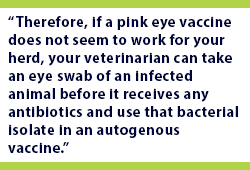
Veterinarian’s Corners: How to Prevent and Treat Pink Eye in Cattle
 By Brandon Scharping, Lena Veterinary Clinic
By Brandon Scharping, Lena Veterinary ClinicPink eye is a painful disease for livestock and a frustrating disease for cattle producers. The economic impact of pink eye in the cattle industry results from a loss in profitability due to increased costs for medical treatments, reduced weight gain, decreased milk production, and devaluation of sale animals due to eye disfigurement. Prevention of pink eye can be difficult because it is a multifaceted disease that can be caused by different strains of Moraxella bovis, Moraxella bovoculi or Mycoplasma bovoculi. However, various preventative health and management factors can reduce the risk of pink eye in your herd.
Fly control
Applying fly tags and using pour-on fly control products can limit face fly exposure. To effectively use fly tags, it is recommended to rotate tag type yearly based on the type of chemical in the tag. This can help prevent insecticide resistance from developing in flies on your farm. It is recommended to use two fly tags per animal. If fly tags are applied too early in the spring, you could lose fly tag efficacy toward the end of summer. Wait to apply fly tags until as close to the beginning of fly season as possible. Multiple pour on fly products can be applied directly to cattle over the back and along the top of the head. Dust bags and oilers can also be used in places where cattle frequently visit, such as waterers, feeders, or alleyways.
Shade and pasture management
Excessive sunlight and tall grass can irritate the eyes and cause cattle to have watery eyes. Scratches in the cornea and increased tear production provide the perfect opportunity for a bacterial infection of the eye to occur. Eye discharge can attract flies and allow flies to spread the pink eye bacteria rapidly. Providing a source of shade and mowing tall grass and weeds can prevent eye irritation.
 Vaccination
Vaccination
A high degree of diversity among pili genes between the various bacteria that cause pink eye is likely responsible for why some herds might see a benefit from vaccination while other herds do not. Therefore, if a pink eye vaccine does not seem to work for your herd, your veterinarian can take an eye swab of an infected animal before it receives any antibiotics and use that bacterial isolate in an autogenous vaccine. Pink eye vaccines are a killed bacterin; therefore, animals need a booster vaccine in about four to six weeks if it has never been previously vaccinated. Autogenous implant vaccines are available that can be administered at one time and still provide a booster immunization. These autogenous implants have a quick-release pellet and a slow-release pellet that acts as a booster vaccination a month later.
Treatment of pink eye
Long-acting antibiotics with label claims for pink eye include oxytetracycline (LA-200®) and tulathromycin (Draxxin®) given at the labeled dosage for bodyweight via a subcutaneous injection in the neck. As soon as you notice tear stains on the face and/or a cloudy eye, treatment should be initiated. Active pink eye infections will have sensitivity to light and eye tearing. Covering the infected eye with a glue-on patch can also limit sunlight irritation and decrease eye discharge, limiting the spread to other cattle. For severely infected eyes with a corneal ulcer, your veterinarian can inject subconjunctival penicillin and suture the third eyelid to act as a flap to cover the eye. The third eyelid flap allows serum from the third eyelid to help repair the cornea and speed up the healing process.
| Category: |
Animal health Fly control Starting Strong - Calf Care |

